Analysis: The All Blacks' game plan for the 2017 British & Irish Lions that got shelved

The 2017 All Blacks came into the Lions tour with the bulk of their 2015-World Cup winners – Jerome Kaino, Aaron Smith, Kieran Read, and Sonny Bill Williams to name a few.
The newest star was Beauden Barrett, at the peak of his powers after his 2016 season, which saw him take over the All Black 10 jersey and win the World Player of the Year award.
The All Blacks side was a powerful one, whilst the Lions came with confidence that the 2005 series result would not be repeated.
As bizarre as the assertion may sound to New Zealanders, the Lions played far more attacking width in this series around their Sexton-Farrell axis than the All Blacks did, even with the form player in the world in Barrett.
The All Blacks attacking shape was actually all about targeted carries at the heart of the Lions’ ruck defence, basing most phases off 9.
In fact, reigning World Player of the Year Beauden Barrett was hardly involved at all in the first Test at Eden Park.
Sonny Ball
It was an unusual pattern the All Blacks used in the first half, with Sonny Bill Williams and Ryan Crotty detached from any sort of traditional back play, instead being used as battering rams like extra ball-carrying loose forwards.
Like pistons, the All Blacks pack worked over the interior defence left, right, left, with the midfielders heavily involved in close.
The midfielders were either outside or inside options off forward runners, or were the primary ball carrier themselves.


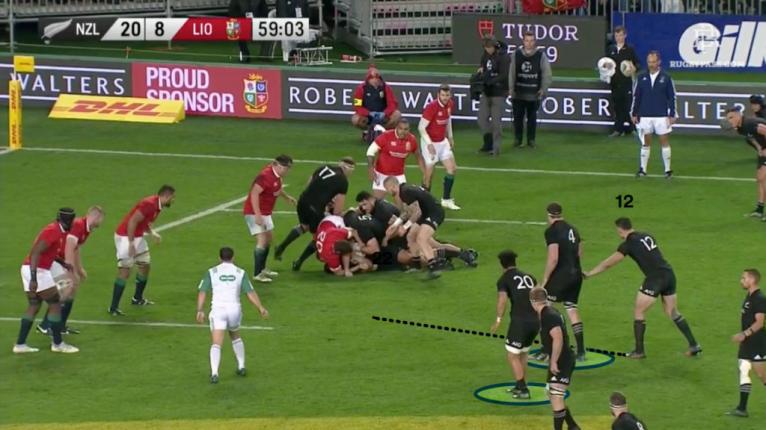
The forward pods often operated in duos alongside a midfield option, while large numbers would re-load on the short side for a switch of play back towards the sideline.

Sonny Bill Williams (12) is set up deep in behind a pod of two forwards, Sam Whitelock (5) and Sam Cane (7), before hitting a flat pass off 9 into the teeth of the Lions ruck defence.

This play was frequent as the All Blacks’ powered themselves forward on Sonny Bill’s carries, as if he was back playing in the second row in the NRL and taking hit-ups.
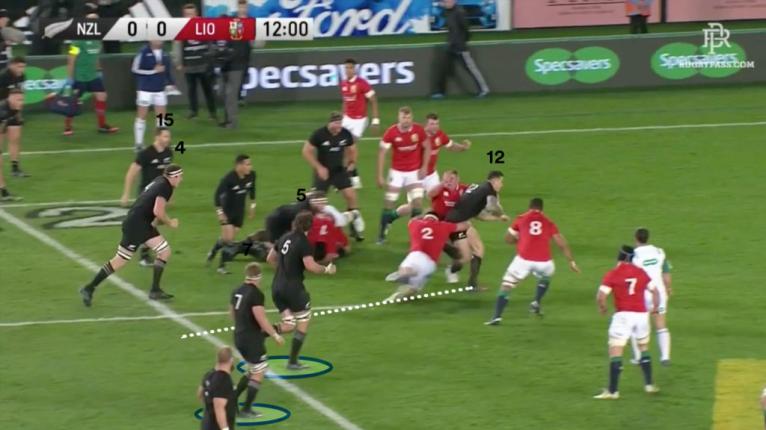
Ryan Crotty (13) was also used as an inside and outside option around these two-man pods.




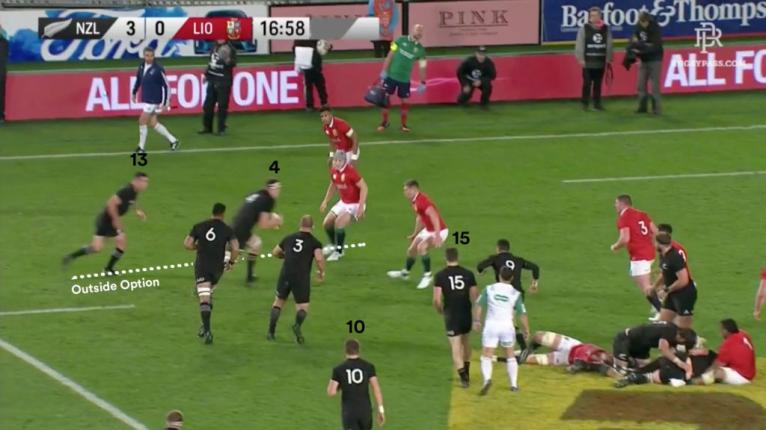
We can also see fullback Ben Smith (15) constantly lurking around behind the ruck, looking for a special one-two play with Aaron Smith that involes the fullback playing halfback and then receiving the ball back on the inside from 9.
In most of the above pictures, we can see around two thirds of the entire All Blacks side spread over no more than 15-metres or so metres of width.
Rugby writer Conor Wilson has theorized that the All Blacks ‘Javelin’ attack in this Lions’ series revolved around a set-piece play involving the 12-13, and in particular, Sonny Bill Williams’ ability to offload.
It may have been much bigger than that.
It could have been an entire operating system revolving around using the midfielders as extra loose forwards to funnel attack towards the heart of the Lions’ defence, wave after wave.
Sonny Bill Williams continued running ‘deep to flat’ lines off Aaron Smith throughout the entire game.
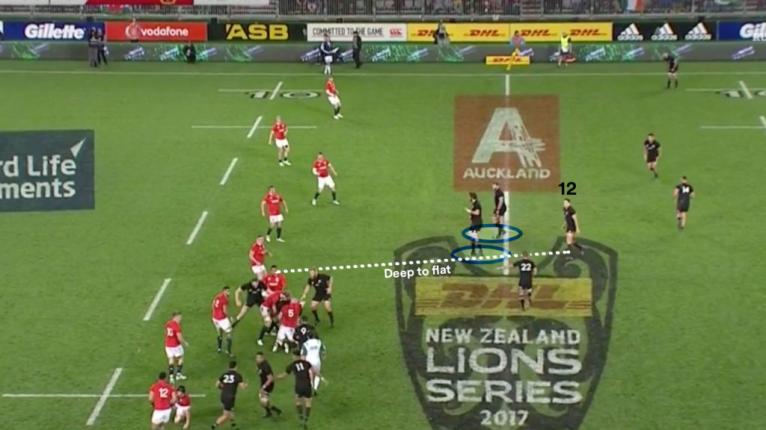
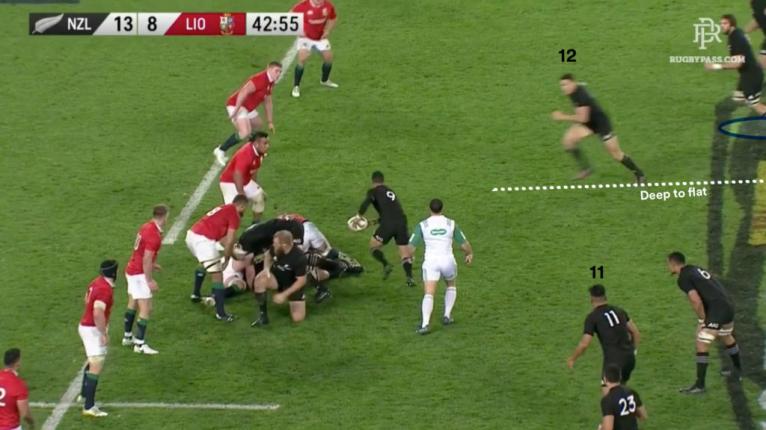
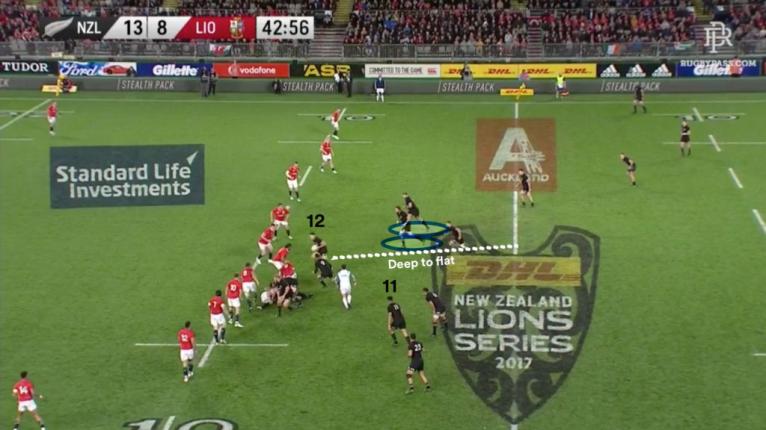
When you see how narrow the concentration of players is, it does look like an arrowhead, hence the moniker of the Javelin.
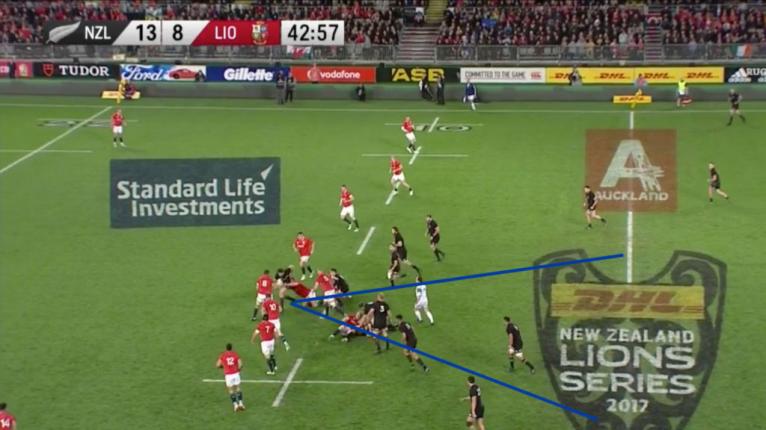
The gain line wins off Williams’ carries added up to big territorial marches into Lions territory, leading to six points off penalties and the platform for the first try in the first half.

There were plenty of turnovers though, as part of the design of the strategy was meant to optimize the use of the offload by the All Blacks’ skilled big men and Williams.
Not all the passes in contact were clean or accurate as an error-strewn half allowed the Lions plenty of counter-attacking ball.
The All Blacks had to also overcome losing key parts. First, Ben Smith was lost in the 27th minute to concussion, forcing Beauden Barrett to fullback. Ryan Crotty was then forced from the field a little while later in the 32nd minute.
Crotty already had clocked up seven carries in 31 minutes.
Sonny Bill Williams finished the game with 17. Three members of the pack ended with over 10 carries, Retallick (12), Read (19) and Cane (15).
The All Blacks’ plan was to match the Lions pack with primal physicality, and bash them up the middle, using one of Hansen’s most prized assets to do so.
It worked to the extent of needing to make metres downfield. It led to points from the field position earned, but didn’t directly result in tries.
The tries came off the moments the All Blacks finally did expand, a quick tap by Aaron Smith and fast hands saw Codie Taylor score the first in the corner and Rieko Ioane’s first was a result of some spectacular hands by Kieran Read to free the backs from a scrum play.
As much as Williams carried hard, his most influential involvement of the night may have been the decoy he provided on Ioane’s first try from the scrum.

Having drawn the attention of Anthony Watson (14), the ball was popped over his head to the three All Blacks in open space on the outside.


These wide shifts were few and far between, however. This attacking system was like a contracted coil waiting to spring, but it took a long time before the spring was let off.
So much attacking activity was cornered to one area of the field, around the ruck, leaving the remaining few backs with acres of width.

When the All Blacks did take the opportunity to go wide, the cross-field kick was a perfect option.

This suited the skillset of Beauden Barrett, and the option was likely kept in mind when the game plan was devised.
He would go without the ball for long periods, but when he did get it, he had the option to fire off his famed kick-pass that was so lucrative at that time in his career.
Except, when Smith went down early, Barrett was moved to fullback and when Crotty was lost to injury, it disrupted the original plans.
The All Blacks brought the same strategy to the pivotal second test in Wellington with some minor tweaks.
Waisake Naholo was brought in for Ben Smith, with Israel Dagg moving from the wing to fullback. Anton Lienert-Brown came into the starting side to replace Crotty at outside centre.
The All Blacks still had their workhorse Sonny Bill Williams, who could provide the bulk of the gain line carries in close quarters.
The conditions were awful, which suited the All Blacks up-front style of play. In the short period of time they had 15-men on the field, we saw similar use of the midfielders, and this time Naholo was also brought in close as well.

Anton Lienert-Brown runs the same inside option that Crotty did in the first test, while Naholo is also lurking to provide latch support.
On the next phase, Sonny Bill Williams is anticipating running a deep to flat line on the opposite side of the ruck.

The conditions made play difficult and turned the game into more of an arm wrestle for territory through the air.
And of course, less than thirty minutes into the game, Sonny Bill Williams was red-carded.
Given Williams’ hefty involvement in the game plan and the conditions unfolding, there arguably couldn’t have been a worse member of the team to get sent off. To compensate, Kaino was subbed immediately for Laumape who could try to generate a similar impact.
As the game wore on, the All Blacks struggled to make the gain-line in the second half as soggy underfoot conditions left tired runners sitting ducks for the Lions defence.
The Lions’ own width game exploded in the final twenty to put together two tries with Johnny Sexton and Owen Farrell critical in their construction.
The visitors levelled the series and the All Blacks were left without Sonny Bill Williams, Ben Smith and Ryan Crotty for the decider.
They had to change as this game plan didn’t suit the new players coming in.
It was also time to free Beauden Barrett who had been relatively restricted in the first test by design and in the second test by the wet conditions.
They shelved this forward-focused narrow game plan for the third Test and let the shackles off so to speak, but two years later the idea still has relevance.
In 2019 the All Blacks pushed the same wide game all through the 2019 calendar and through the World Cup.
It came unstuck against England, particularly in the second half, where the predictability of the pattern led to punishing hits and huge gain line losses.
They couldn’t figure their way out of it, but this kind of operating change may have proved useful to get forward.
It worked in the first test against the Lions as a means to gain large chunks of territory to set up a prime attacking position.
The Rugby Pod | Season 4 | Episode 22:










































Comments on RugbyPass
Some dumb selections there. Not Porecki Not Donaldson Not Gordon Not Lonegran - both Not Nic White - Fines instead Not Liam Wright Not Paisami Definitely not Vunivalu Other than that not bad.
1 Go to commentsI've never been convinced that Patty T is a test match all black. Otherwise I probably agree it's the best side available to beat the poms. Caveat that Codie Taylor is yet to be seen and could very likely warrant selection by June. I hope that Razor brings the young loosies, half backs and locks into the training squad and develops/ selects the best
7 Go to commentsYou doing the same thing I disliked about the example of Samisoni Taukei'aho, Nick. He’s great the way he is, you’re trying to do what modern-day coaches frustrate me doing, turning everyone into the perfect athlete. Next thing you’ll be telling me you’ll bench him until he’s hit that arbitrary marker, and can’t overtake the current guy who’s doing all his workons. He’s a young Kieran Read, through and through, plays wide and has threat, mainly (and evident in your clips) through his two hand carry and speed. Just let him work on that, or whatever he wants, and determine his own future. Play God and you risk the players going sideways, like Read did, instead of being a Toutai Kefu. I mean I was in the same camp for a while, wanting our tight five to have the size, and carry ability, as the teams they were getting beat by. Now I’m starting to believe those teams just have better skilled and practiced individuals, bigger by upwards of 5kg sometimes, sure, but more influentially they have those intrinsic skills of trust and awareness. Basically our guys just didn’t know wtf they were doing. Don’t think I’m trying to prove a point here but hasn’t Caleb Clarke been in much better form this year, or does he just ‘look’ better now that he’s not always trying to use his size?
43 Go to commentsThe pack lacks a little in height for the line out and I wouldn’t be completely convinced by some of the combinations till we see it in action.
7 Go to commentsThe side is good but lacks experience. International playing bona fides udually trumps super rugby form for good reason. And incumbents are usually stuck with. Codie Taylor should start or come off the bench. B Barrett will start at fullback. Blackadder has not earned the position, Finau has. TJs experience and competitiveness earns him a starting role, Christie or Ratima off the bench
7 Go to commentsPretty good side. Scott Barrett should be the captain. Ethan Blackadder a great choice at blindside. He is going to go from strength to strength having made a couple of starts for the Crusaders. Scott Robertson rates him highly. Perenara could start a no 9.
7 Go to commentsI question and with respect. Was enough done over the last few years to bring through new blood knowing the Whitelocks and co couldn’t last forever. There should have been more done to future proof the team. New squad new coach, he and they weren’t set up well. IMO
6 Go to commentsJacobsen will definitely be in the 23
7 Go to commentsLots of discussion points, Ben, but two glaring follies IMO: 1. Blackadder at 6. Has done nothing so far this season to justify his selection. Did you see him going backwards in contact at the weekend? Simply has not got the physical presence at 6: we need a Scott Barrett or a Finau (or wildcard Ah Kuoi), beasts who are big enough to play lock, like Frizzell. If Barret played at 6, Paddy could be joined at lock by Vai’i or one of the young giants we need to promote, like Darry or Lord (if he ever gets on the field). Blackadder best left to join the queue for 7. 2. Not even a mention for Christie? Ratima gets caught at crucial times at the back of the ruck when he hesitates on the pass. The only way he starts would be if Christie and TJ are injured.
7 Go to commentsWhat a dagg in more ways than one
6 Go to commentsRegroup come back next year but sack some of the coaching team and don't be like the ABs last minute sacking. If Crusaders don't do well ABs don't do well.
5 Go to commentsProctor Definitely inform again this year had a hell of a season last year and this year is looking even better. Still mixed feelings about Ioane tho.
4 Go to commentsDagg is still trying to get enough headlines to make himself relevant enough to get a job. The Crusaders went back to square one at all levels. Shelve this season and nail the next one.
6 Go to commentsHe was in such great form. Sad for him but only a short term injury and it will be great to see him back for the finals.
1 Go to commentsAfter their 5/0 start, I had the Crusaders to finish Top 4 only…they lost the plot in Perth but will reload and back themselves vs 4th placed Rebels…
5 Go to commentsBoth nations missed a great opportunity to book a game that would have had a lot of interest from around the world. I understand these games can’t be organised in 5 minutes but they should have found a way to make it happen. I don’t think Wales are ducking anyone but it’s a bad look haha.
3 Go to commentsIt will be fascinating to see the effect that Jo Yapp has. If they can compete with Canada and give BFs a run for their money that will be progress
1 Go to commentsFollowing his dream and putting in the work. Go well young fella!
3 Go to commentsPerhaps filling Twickenham is one of Mitchell’s KPIs. I doubt whether both September matches will be at Twickenham on consecutive weekends. I would take the BF one to a large provincial stadium so as not to give them the advantage and experience of playing at Twickenham before a large crowd prior to the RWC.
3 Go to commentsvery unfortunate for Kitshoff, but big opportunity potentially for Nché to prove he is genuinely the best loosehead in the world, rather than just a specialist finisher. Presuming that if Kitshoff is out, it will also give Steenekamp a chance to come into the 23? Or are others likely to be ahead of him?
1 Go to comments